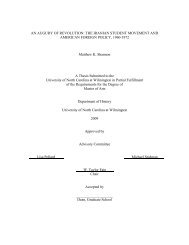Saprolegnia - The iLumina Digital Library
Saprolegnia - The iLumina Digital Library
Saprolegnia - The iLumina Digital Library
Create successful ePaper yourself
Turn your PDF publications into a flip-book with our unique Google optimized e-Paper software.
<strong>Saprolegnia</strong> torulosa is an exceptionally variable species, but all the isolates we<br />
have examined express two characteristics, namely catenulate oogonia (which may or<br />
may not disarticulate; Fig. 97 A), and predominantly diclinous antheridial branches<br />
(Fig. 97 A, B) of varying densities. In a few instances watermolds identified as S. torulosa<br />
have been described as having oogonia positioned in terminal, discharged, primary<br />
sporangia (Fig. 97 D). This feature, however, is also quite characteristics of S. ferax. In<br />
his description of S. monilifera (=torulosa) from Japan, Nagai (1931:8) wrote that an<br />
antheridium-like “body” formed from the basal septum of the oogonium but was not<br />
involved in fertilization. Prominent protrusions or extensions of the septum into the<br />
oogonial cavity are commonly encountered in species of <strong>Saprolegnia</strong>, but are of no<br />
consequence taxonomically.<br />
<strong>The</strong> lengthy synonymy suggests that <strong>Saprolegnia</strong> torulosa has had a less than<br />
tranquil taxonomic history. For the most part, contradictory reports on the morphology<br />
of the species seem to have centered on the abundance of antheridial hyphae in isolates,<br />
and whether or not the catenulate oogonia disarticulated. Seymour (1970) first directed<br />
attention to the uncertain status principally of three species -- S. torulosa, Isoachlya<br />
(=<strong>Saprolegnia</strong>) toruloides, and S. monilifera de Bary. He was unable to resolve the<br />
taxonomy of these species, and considered them imperfectly known. From a<br />
comparative study of a number of specimens from Iceland, Howard and his<br />
collaborators (1970) succeeded in defining S. torulosa in a broad sense, and justifying a<br />
lengthy synonymy. Reed (1973:43) did not follow the nomenclature proposed by<br />
Howard and his associates. In a thesis manuscript Reed made a new combination (I.<br />
toruloides was the basionym): <strong>Saprolegnia</strong> toruloides (Kauffman and Coker). As this name<br />
has not been published it is excluded.<br />
Howard et al. (1970) established experimentally that antheridial branch<br />
abundance and the tendency of oogonia to disarticulate could be modified in<br />
<strong>Saprolegnia</strong> torulosa. It is reasonable to suppose that the reported absence of antheridial<br />
branches in some specimens (earlier identified as I. toruloides, for example) was<br />
attributable to the evanescent nature of these filaments. <strong>The</strong> analysis of <strong>Saprolegnia</strong><br />
torulosa by Howard et al. (1970) leaves no doubt that there are no sharp distinctions<br />
among the elements of the torulosa complex. Seymour’s (1970:64) views support the<br />
disposition of taxa proposed by Howard and his associates.<br />
In connection with a watermold isolated from Madeira Island Höhnk (1962) used<br />
the name Cladolegnia toruloides (Kauffman et Coker) Johannes. This is an error since<br />
Johannes (1955a:212) included Isoachlya toruloides with <strong>Saprolegnia</strong> torulosa, and not as a<br />
new combination in his genus Cladolegnia.<br />
CONFIRMED RECORDS: -- BRITISH ISLES: E. M. Brown (1938:166); R. A. Couch<br />
(1951:115, pls. 22-24); O’Sullivan (1965:323, 343, figs. II-50- 60, II-62-74). CANADA:<br />
Maestres (1977:147, figs. 14-20). CZECHOSLOVAKIA: Cejp (1934:88; 1957: fig. 119, 1;<br />
1959a:203, 207, figs. 72-75). DENMARK: A. Lund (1934:17, 18, figs. 6a-e). FRANCE:<br />
Lechmere (1911a:169-174, 175, figs. 1-19 (p. 170), 1-16 (p. 172); 1911b: fig. 1); Moreau and<br />
626
















